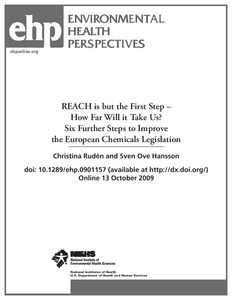REACH is but the first step. How far will it take us? Six further steps to improve the european chemicals legislation
"Background: The main aims of the European chemicals legislation, REACH, are to generate more knowledge about the hazardous properties of industrial chemicals and to improve chemicals risk management. Objectives: In this paper we analyse how much data will in fact be generated within REACH. C...
| Main Authors: | , |
|---|---|
| Institution: | ETUI-European Trade Union Institute |
| Format: | TEXT |
| Language: | English |
| Published: |
Environmental Health Perspectives
2009
|
| Subjects: | |
| Online Access: | https://www.labourline.org/KENTIKA-19174978124919921509-ReaCH-is-but-the-first-step.-H.htm |
| Summary: | "Background: The main aims of the European chemicals legislation, REACH, are to generate more knowledge about the hazardous properties of industrial chemicals and to improve chemicals risk management.
Objectives: In this paper we analyse how much data will in fact be generated within REACH.
Conclusions: It is concluded that the data requirements for many endpoints have still not been determined but depend on prioritization criteria and waiving practices that will be decided in the years to come. We propose six important steps towards an improved REACH: The implementation decisions should ensure that sufficient data is obtained to make a first hazard assessments of as many substances and endpoints as possible; An effective process should be created for identifying Substances of Very High Concern and for making the appropriate risk management decisions for these substances; There is a need to develop tests and other approaches so that the information requirements can be satisfied taking into account resource limitations and the aim to reduce animal testing; Similar data requirements as those currently required for substances produced or imported in 10 tonnes or more/year should be introduced also for substances produced or imported in over 1 tonne/year; The control of substances incorporated in articles needs to be addressed; Lack of data should be systematically reported and included as a basis for risk management. " |
|---|---|
| Physical Description: | 24 p. Digital |

